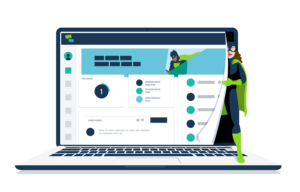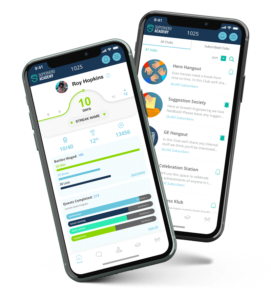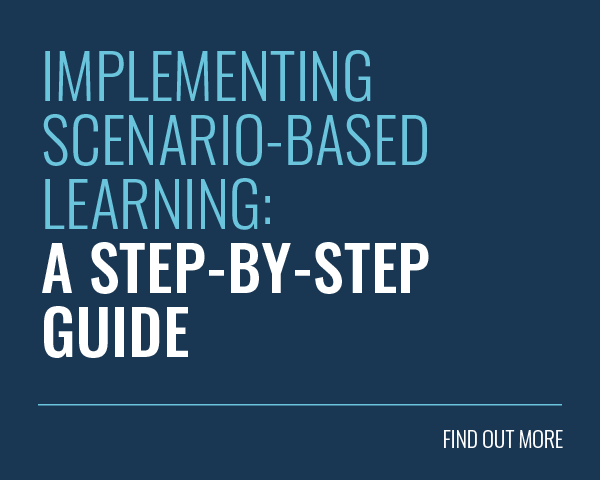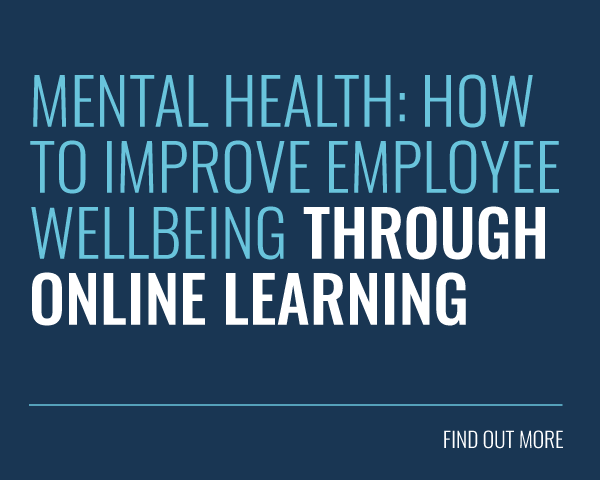
150 tips is a lot of tips but this is a topic that’s close to our heart. And, by happy accident it represents one tip for each of Queen Elizabeth I’s 150 wigs!
Whether you work for a large corporate and are looking to engage suit-wearing executives, or you work for a trendy startup with an audience that prefers to complete training from the office ball pit, we have a bounty of tried, tested and approved engagement tips.
They will help you attain the learner engagement you need to bridge the gap between knowledge and behaviour change and deliver real business impact.
Content
- Learners love video content. In fact, they are 75% more likely to watch video than read documents and articles.
- Eliminate all stock imagery from your content and platform. Eye-tracking studies have shown that we pay close attention to images when they contain relevant information and we ignore images when they don’t.
- Instead, use illustrations and colourful imagery to bring your learning content to life.
- Never let your content run dry. Plan the release schedule in advance and pre-empt any gaps/risks that may be involved with your content strategy.
- Use scenario-based learning to help demonstrate the consequences of your learners’ actions, in a risk-free environment. Practice makes perfect after all.
- Learning objectives don’t have to be boring! Keep them simple, clear and make sure learners understand what they’ll get from your content.
- Unleash your inner Tony Robbins and share daily learning motivation with your learners by posting motivational messages or inspirational videos in your social feeds.
- Channel your inner Ernest Hemmingway and ruthlessly eliminate bloat from your content. www.hemmingwayapp.com will help you communicate as concisely as possible.
- AI, HR, SME, L&D, XAPI, LMS, LXP… KMN. Wherever possible avoid jargon and acronyms.
- Fulfil your secret dream of becoming an author by layering narrative onto your content. Cognitive psychologist, Jerome Bruner, suggested information in narrative format is 22 times more memorable!
- Introduce “By request only” content from third parties.
- “By request only” content helps you identify your engaged learners who are looking for development.
- Add a special badge to “by request only” content. Having this content marked and certified will ensure that the dedicated are recognised and it feels like a true achievement!
- Topical issues will always draw an audience, so don’t be afraid to address them. Relevancy is important!
- Regularly run reports on your content. Keep track of who is consuming what and how long is being spent on your training. Your most engaging and your most disengaging content will give you the most insight into what your learners love and hate.
- Did you know half of all American millennials listen to podcasts each month? They’re a popular format for digging deep into topics. Consider sharing podcasts and creating your own!
- Create content that serves your learners’ goals, not just your goals. Help your learners become who they want to be!
- Let your subject matter experts loose on an easy-tov-use authoring tool. That way they can become part of your content creation army! Ensure the tool is easy to use and offer rapid authoring functionality. Your content creators need to be ready to react at the speed of need! If you’re looking for a rapid authoring tool, look no further than our very own Genie!
- Learning isn’t a moment in time, it’s a journey. To better reflect this fact, structure your learning into campaigns. Campaigns are the best way to generate and track engagement.
“Inside everyone is a hero just waiting for the knowledge to change the world.”
Growth Engineering
- People want to be inspired! Why not share inspiring quotes about learning as a push notification?
- eLearning is an opportunity to maximise engagement, not deliver a slide deck online! Keep bringing your learners’ focus back to learning by incorporating interactive elements and fun-focused approach.
- Giving your learners access to a whole library of training content is curiosity-inducing. But, it’s hard work if you create it yourself. Brands like iAM Learning and OpenSesame offer amazing content libraries full of useful training materials for your learners to explore.
- Why not add fun Easter eggs to your content? Easter eggs are hidden surprises your learners will love. They could be anything from a video of your CEO doing karaoke to a fun fact about how the business was founded.
- Encourage reflective practice using tools like the Discovery Method. The DIscovery Method allows you to ask learners open questions which help them relate their training to their day to day work life. This helps learners appreciate the value of training.
- Upgrade your content with an editor. They can help you refine your message and make text easier to understand.
Gamification

- Reward your learners with Badges and XP early on in their learning journey, so they get hooked immediately.
- Make gamified rewards progressively harder to earn. This makes learners feel like they’re growing and developing.
- Blur the lines between online and offline learning by using QR codes to create a treasure hunt.
- Use Battles to add an addictive competitive element to your learning content. Battles are learner vs learner quiz-offs which drive unprecedented engagement levels. The average learner using Battles completes 810 Battle questions each month!
- Purchase incentive items that can be branded and used around the workspace (mugs, mouse mats, stickers, pads, pens, etc). They act as a constant reminder to return to your learning hub.
- Tie XP and Badges to real-life rewards or even an extra day of holiday.
- Use Battle Squads to pitch territory against territory. This turbocharges team spirit and will help your learners pull together to complete more training for the sake of their team.
- Reward learners with Badges when they complete content. This will give them the urge to complete the set and collect all the badges attached to your content.
- Do you ever get nervous about investing in rewards because you’re afraid you’ll spend all that money and you’ll still get no engagement? Try using stretch goals! They’ll give you risk-free results! Here’s how they work:
- Step 1: Start with a small reward.
- Step 2: Learners who complete the content are entered into a prize draw on your deadline date.
- Step 3: As more learners complete the content, you reach stretch goals. With every stretch goal, the prize gets better and better.
This setup encourages learners who have completed the content to become evangelists for your campaign! They want the best possible prize, so will want their colleagues to complete the training and increase the reward value even more!
- Don’t underestimate the power of the words ‘Limited Edition’. Consider releasing limited edition training or Badges and your learners to grab your learners’ attention.
- Set team goals, such as cumulative XP earned over a specific period of time. You could display this as a thermometer style bar on a learning management system banner and update it as milestones are reached.
- This goal could be linked to charitable donations for extra motivation!
- Structure your content in the form of a tournament or a league. As learners complete content and win Battles, they earn points and climb the leaderboard. Those at the top of the leaderboard are then entered into a final round.
- Use Value Badges to allow your learners to reward one another for living out your organisation’s values.
- Use game templates carefully. They can act as incentives at key milestones to encourage your learners to continue.
- Alternatively, use game templates as a monthly challenge for your learners. Highest score earns a special Badge!
- Levels are the ideal way to arrange learning pathways for maximum engagement. They provide clear goals, incentives and visual consistency.
- Add narrative to your Levels to grip learners and keep them wanting more.
- Make sure to include a mini Leaderboard for each learner. They will want to see who’s behind them and who’s ahead. A top ten or a gigantic leaderboard can feel overwhelming!
- A Leaderboard dedicated to new starters is the perfect way to engage them from day one. Competing with your fellow new starters is fun, but competing with established employees feels daunting!
- Log in Streaks keep learners coming back, but try adding some creative Streaks as well. For example, a streak for winning Battles or a Streak for posting in a Club.
- Assessments with certificates attached can be engaging, not because they are fun but because they prove the value of your content.
- Deploy a consistent gamification strategy across your platform. Make sure learners earn points consistent with the amount of effort they put in. This will ensure everything feels fair and stays engaging.
- You can set challenges and give learners wildcards as a reward. For example, if they can post an example of a tough customer conversation they had and how they used their training to combat it, you can reward them with double points for a month.
- Consider the experience of new users on an established platform. You don’t want them to feel disengaged when others are on thousands of XP above them. It should always be achievable for a new starter to reach the top if they complete all the training.
- Inject fun into your learning platform. Create an arcade space with links out to free browser-based games like A Dark Room and Slither.io. If you update this area regularly, you can provide another incentive to keep your learners coming back.
Social

- Social features are a powerful way to build communities on your platform that keep learners coming back.
- Use Clubs to create focused discussion groups where learners can dive deep into the topics they’re passionate about.
- Use social features to identify advocates of your training and work with them to get everyone excited about your learning initiative.
- Set challenges in your social feeds to help learners cross the bridge from knowledge to behaviour change.
- Why not create a shared Spotify playlist for your learners? Listening to music can reduce anxiety, blood pressure and pain as well as improve sleep quality, mood, mental alertness, and memory.
- Find people who have experienced real success with their learning and development. Record testimonials and share these to inspire others.
- Use open questions to start conversations in social feeds.
- Take a stance on a topic and use that as the basis for a discussion. For example ‘This is the best way to sell this product…’
- Regularly share good news on your platform. If your training has a stratospheric ROI, make sure everyone knows about it! Has your business purchased a new office, or closed a big sale? Share the good news!
- Share messages from your senior leadership team on the platform. Why not welcome new starters with a hello from the CEO?
- Livestreaming is the best way for your learners to share their knowledge and it’s powerfully engaging. In fact, the livestreaming market is growing 99% year-on-year!
- Allow learners to subscribe to each other. That way they can learn from the people who know the most.
- Make your training feel more human. From profile pictures to videos, it will make your platform feel like a community.
- Use your social feeds to give shoutouts to your most prolific learners or your biggest contributors.
- Make sure you take time to comment, react and moderate all social learning spaces. This will ensure people feel the platform is active, fun and respectful. It also models what good platform use looks like!
- If you have an area of the business that is difficult to engage, recruit a member of that team to help you offer something that resonates with that group. If you win them over, then they can even act as an advocate for your learning initiative.
- Show your subject matter experts that you value them. Consider hosting a thank you event for their contributions.
- Even better, why not host a dedicated awards event for your SMEs?
- Could your platform use a hero? Create an Admin account that uses a hero character who answers people’s questions and ‘saves the day’.
- Every hero needs a villain. Adding a villain account makes it easy for you to create fun moments (and gives you an opportunity to say those things you always wished you could!).
- Make sure your LMS has a social club which isn’t about work and is instead about building community.
- Ask the senior leadership team to regularly engage on the platform. A CEO replying to your post can be profoundly engaging!
- Sometimes challenges go viral on social media. Why not get people to share these posts on your LMS as well? After all, they’re usually for a good cause!
- Make your LMS the centre of innovation by using upvotes and downvotes. Why not suggest new employee perks or business ideas and then allow your employees to vote?
- Consider arranging weekly events in your social channels using hashtags. People can post their questions into the chat, for example #AskMarketing or #HRhour. You’ll be amazed how many learners have burning questions they won’t ask without a forum like this.
- Host an Ask Me Anything (AMA) event on your platform. An AMA allows online audiences to submit questions to an expert or influencer.
- For special events, consider getting industry thought leaders to do an AMA or share their insights.
- Vlogs are an easy way for your learners to share their knowledge and you can be sure their peers will love it. Encourage learners to regularly share video tips and updates.
- In-line translation on social feeds allows people from different territories to chat and share knowledge with no language barriers whatsoever.
- Why not pair territories for a month at a time? They can enjoy a cultural exchange and share siloed knowledge!
Epic Meaning & Personalisation
Help your learners understand their epic meaning. Epic meaning is the idea that everyone wants their live to matter and to be a part of something bigger than themselves.
- Consider creating a sub-brand for your LMS that reflects your organisation’s epic meaning!
- Set clear goals for all your learners. They should have a clear pathway of development with a clear description of the end result. This helps training move from a series of moments in the learner’s mind, to a journey of self-improvement.
- Bring the wording on the platform in line with your organisation’s brand. Perhaps the home page might become ‘The Forum’, or ‘The Common Room’.
- If your business has an exciting project going on, consider linking it to your LMS. Is sustainability a big goal for your business? Why not call points seeds and and plant a tree for every 100 seeds earned. There are services that can support you with this endeavour.
- Use personalisation to help your platform feel like home to your learners. Small things like addressing learners by name go a long way!
- Use the power of epic meaning to help your learners feel like they’re a part of something bigger than themselves.
- Communicate your organisation’s mission and values through your platform’s imagery, language and colour scheme.
- Work hard to shield learners from irrelevant content and to direct them towards relevant content.
- One of the key causes of disengagement in learning is a lack of challenge. Make your content challenging and it will release feel-good chemicals in your learners brains when they overcome the challenge.
- Similarly, don’t force your learners to complete content on topics they already know.
- Festive hype can help you engage your audience. Consider an advent calendar of learning.
- At Easter, why not hide Easter eggs across your platform with a prize for everyone who finds them all?
- Get your learners excited about New Year by asking everyone to come up with one New Year’s resolution focused on learning.
- A theme for your platform can make it much more fun. It might be an Academy for Superheroes, Knights of The Round Table, School of Rock or a quest to save the world!
- Authenticity is important. If a learning platform feels corporate and inhuman, your learners won’t connect with it.
- If you feel like your platform has come a long way since launch, why not hold a relaunch event with a brand new design to get everyone back on and engaged?
- Create a selection of fun branded wallpapers for all work devices so that everyone is reminded to learn every day.
Administration
 Use your engaged learners as ambassadors. Give them a special profile image, a title on the platform and consider making them an Expert. They will know all the tips and tricks and will enjoy supporting and encouraging others.
Use your engaged learners as ambassadors. Give them a special profile image, a title on the platform and consider making them an Expert. They will know all the tips and tricks and will enjoy supporting and encouraging others.- Advertise your learning platform upwardly within your business as a tool for education and something that can be harnessed.
- Use Google Analytics and other reporting tools to help you understand which areas of your platform your learners love (and areas that need a little more attention).
- Use events and holidays as an opportunity to revamp your learning platform with festive fun.
- Introduce new and novel features on a regular basis. This will keep your learners intrigued.
- Use AR to creatively deliver training at the point of need.
- Give yourself time every 6 months to run a full health check on your platform. Keep it clean and look over it with fresh eyes. Ask yourself, what are you missing and what isn’t working?
- If delivering a cornerstone training campaign, consider using VR to intrigue your learners.
- Launch your LMS in phases, adding extra functionality at each stage. This both makes it easier to launch your solution and helps maintain excitement for longer.
- Use a promotional widget to let your learners know why your training matters. Don’t just announce that new training is coming, but explain why they should care.
- Invest time in regular training needs analysis. Providing your learners with relevant content makes it much easier to engage them!
- Group content into seasons and let learners know when a season will start, how much content will be released and when it will end. It allows them to follow along, not miss out and prevents fatigue.
- Keep track of your own milestones. For example, the second anniversary of the platform launch, 10,000 users, 1,000,000XP earned. Make sure you celebrate this with your learning community.
- Promote a new training campaign through ‘guerrilla’ marketing tactics. This could be everything from a poster campaign through to a flash mob in the all-hands meeting.
- If content is found to be disengaging make sure to remove it as soon as possible and evaluate what went wrong. Then you can try again.
- Link your LMS to career progression. Help you learners understand what’s required for them to grow within your organisation.
- Set a known business expectation on how long your learners should spend learning each week. You can then check this through Google Analytics to see if you are above or below your target.
- Integrate learning into your onboarding process and don’t take your foot off the gas. That way learners will know from the start that it matters to your organisation.
- Use events to unveil new training campaigns. Don’t be afraid to make a big deal out of your big projects! There are few better ways to get buy-in than making people happy.
- Engaged employees make for engaged learners. If you can support HR with engagement campaigns then that’s a great use of your time. Learners who are unhappy in their job don’t complete training content!
- Provide regular self-assessment milestones. Self-assessments allow learners to decide for themselves how they think they’re growing. This can be a powerful way to keep them engaged with training.
- Regularly run user reports to find your most engaged learners and email them to say thank you. Why not award them an engagement praise badge?
- Make sure you do countdowns on your platform to any big events or new releases. The countdown should be shown at least two weeks before the event to give plenty of time for learners to get excited about it.
- Run feedback sessions with your most engaged users and least engaged users to understand what is exciting people and what is holding people back. Doing more of the effective stuff and less of the painful stuff will have a high impact.
- The wellbeing of employees has an impact on their engagement with learning. If they’re tired, overworked, stressed or even just hungry, it can dent their enthusiasm. Consider investing in wellbeing training and working with management to make your company a great place to work.
- Compliance training is doubly hard to make engaging, but it is important. Go over and above to make it enjoyable, otherwise learners might associate your LMS with compliance drudgery!
- Consistency is essential. Make sure your learners know when to expect new content. If you release training on a Thursday at 3pm, make sure you release it every Thursday at 3pm.
- By attaching Google Analytics to your platform you can run an Audience Insight Report. This lets you know what your learners are interested in outside of work. If you spot key trends, why not reflect this in your training and prizes?
Learning Platform
 Make the experience as easy for your learners as possible. Confusion will undermine their engagement quickly.
Make the experience as easy for your learners as possible. Confusion will undermine their engagement quickly. - Awarding your learners certificates for completing curricula gives them something they can share on LinkedIn and feel proud of.
- Learners love to explore. Give them free reign of the whole platform and all the content. You’ll be surprised how much they consume!
- Learners will love a beautiful looking platform. A gorgeous UI will help them immediately trust the platform and keep coming back.
- Accessibility is important! We need to remove all barriers to learning for everyone.
- Don’t think of your learning platform in isolation. Your learners use lots of different software. You might find integrations between software a helpful way to keep bringing learners back to your platform.
- Carefully integrate your classroom training into your online platform. Using tools like Clubs, Battles, Badges and classroom management functionality helps to support an effective blended learning approach.
- Carefully track the business impact of your training and share it with your learners. If you learn that salespeople who complete more training perform 75% better, leverage this fact to encourage others to engage with your training programme.
- Why not make your LMS a space where your learners can show off some of their interests from outside of work? You can do this by adding extra fields to the profile area. Why not add in a field for hobbies and interests outside of work?
- The biggest musicians in the world enjoy surprising their fans with a surprise album release. Why not stun your audience with a surprise release?
- Minmise clicks to content. If your content is hidden behind a maze of navigation, it doesn’t matter how fun it is!
- Create a relaxation space with videos and techniques for meditation, and stress management. The more reasons someone has to visit your learning space to rest, relax, excite and learn, the better!
- A clear to-do list is essential for learner engagement. If your learners have clear goals then they know exactly what to get on with.
- Deadlines can be a great way to make sure content actually gets done. Sometimes a deadline is all a learner needs to start making real progress.
- Provide a space for learners to request training they’d like to receive.
- Let learners use a favourites folder to create their own playlist of best-loved content.
Mobile
 Native apps allow you to tap into all the functionality of a smartphone.
Native apps allow you to tap into all the functionality of a smartphone. - Push notifications are a phenomenally powerful way to reach your learners.
- Deliver the right content on the right device. Shorter content is well matched to mobile, whilst longer content should be reserved for desktop. Similarly, think about whether interactivity will be better suited to a mobile or a desktop interface.
- Online/offline sync on an app allows your learners to complete content regardless of internet connection.
- Microlearning can be the perfect way to engage learners on mobile devices. It means learners can consume content whenever and wherever suits them.
Final Word
- No audience is unengageable. Growth Engineering have been in the learner engagement business for decades and we know for a fact that every single organisation can engage their learners.
- If you want to learn more about engagement and how you can engage your learners, why not get in touch with the undisputed engagement experts by clicking here?





